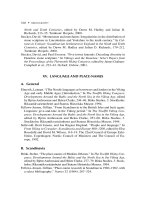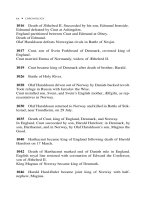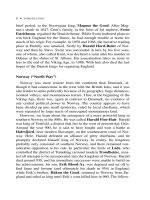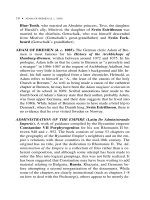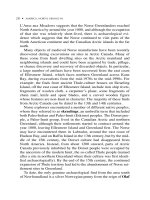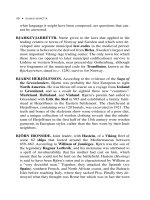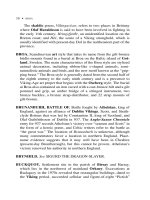The A to Z of the Vikings 2 pot
Bạn đang xem bản rút gọn của tài liệu. Xem và tải ngay bản đầy đủ của tài liệu tại đây (57.5 KB, 10 trang )
(Denmark, Norway, and Sweden) and the places they visited, as it were,
in modules on the Vikings at home and abroad, and especially in the
British Isles. Aside from this, she has undertaken several research proj-
ects dealing mainly with runic inscriptions. Dr. Holman has also pub-
lished a number of articles, again largely on runes, but also on other as-
pects of the Vikings and Viking Age. Her specialization requires method
and precision, something perhaps a bit remote from adventure, but for-
tunately providing a stronger foundation for any interpretation or con-
clusions.
Jon Woronoff
Series Editor
x•EDITOR’S FOREWORD
xi
Reader’s Note
A dictionary is, of course, organized alphabetically, but when it comes
to the Vikings, this is not as easy a task as it may sound: there are a num-
ber of additional characters in the Scandinavian and Icelandic
languages, å, æ, ä, ö, ø,
ð,
þ
, which have to be included. As this dic-
tionary is primarily designed for an English-language audience, which
may include people unfamiliar with the conventions of the Scandina-
vian and Icelandic languages, I have chosen to anglicize these charac-
ters. Thus, å and ä, are treated simply as the letter a; æ as the letters ae;
ö and ø as the letter o; sometimes I have replaced
ð
and
þ
with the let-
ters th, which corresponds to the sound represented by
ð
and
þ
; how-
ever, where a spelling with the Icelandic characters is very well known,
I have kept the original letters but treated them as th for the purposes of
alphabetizing. The length markers over vowels (´) have been retained in
spellings where there is no generally accepted anglicized form but ig-
nored in the alphabetical ordering of entries. Hooked o has been nor-
malized as ö and hooked or nasal a as ã.
The forms of personal and place-names are a further source of
headaches for the person seeking to provide a work of reference such as
the The A to Z of the Vikings. In this book, I have used anglicized
spellings of place names where these exist and are presently well known
(e.g., Copenhagen not Danish København; Reykjavik not Icelandic
Reykjavík), but otherwise I have used the form found in the relevant
country of origin (e.g., Swedish Skåne not archaic anglicized form Sca-
nia; Danish Sjælland not archaic anglicized form Zealand). Personal
names are tricky because all original forms are, to some extent, nor-
malized, sometimes according to different conventions; and many also
exist in different, more modern forms, as well as in a variety of angli-
cized forms. It is hard to be consistent, but I have generally used
anglicized or modernized English and Scandinavian forms where these
exist and are well known in English-language historiography; otherwise
I have used the standardized Old Norse forms. The names of people
from other areas—particularly Arabic and Byzantine figures—are given
in the form most commonly found in modern works on the Vikings.
In order to help the reader, I have also cross-referenced entries with
a number of different forms. For example, the entry for King Cnut the
Great is found under CNUT, but people who look under CANUTE or
KNUT will be redirected to CNUT. Where names are given in their an-
glicized form, I have tried to include their original form in brackets to
assist the reader in further research. Readers should also note that, as is
the convention, historical figures are listed under their first names not
their surnames (if indeed any surname is known). Thus Snorri Sturluson
appears under SNORRI rather than STURLUSON.
The titles of written works are generally listed in both their original
language and in English, when a well-known translation of the title ex-
ists. Where two or more versions of a title are in common usage, the full
entry is normally given under the English title, as befits a dictionary de-
signed for an English-speaking audience (e.g., The entry for the Ice-
landic work Íslendingabók is given under Book of the Icelanders, but
those who look up Íslendingabók will be referred to the correct place in
the dictionary). All entries are provided with either a translation of the
title into English or the original form of the title as is appropriate.
Some standard acronyms are used in the text of the dictionary: OE
for Old English and ON for Old Norse. When referring to runic in-
scriptions, I have supplied the reference numbers of the individual
inscriptions as found in the published editions. For example, DR refers
to the number of the inscription as found in Danmarks Runeindskrifter;
U refers to an inscription published in Upplands Runinskrifter; and N
refers to Norges Innskrifter med de Yngre Runer (see Bibliography:
Scandinavian Sources).
Finally, cross-references are given in bold type.
xii • READER’S NOTE
xiii
Chronology
c. 705 Foundation of Ribe, Denmark.
c. 710 Willibrord’s mission to Denmark.
737 Earliest sections of Danevirke constructed in Denmark.
c. 750 Foundation of Birka, Sweden, and Staraja Ladoga, Russia.
786–802 Reign of King Beorhtric of Wessex; Anglo-Saxon Chroni-
cle recorded attack on Portland, Dorset, England, by men from
Hordaland, Norway.
793 Monastery of St. Cuthbert on Lindisfarne, Northumbria, England,
attacked by Vikings on 8 June.
795 Viking attacks on Rechru (=Rathlin Island off northern Irish coast?)
and Scottish Hebridean island of Skye recorded by Annals of Ulster.
799 Vikings attacked monastery of St-Philibert on Noirmoutier, off
Brittany coast, Frankia.
800 Coastal defenses against Vikings organized by Charlemagne.
802 Monastery on Hebridean island of Iona attacked by Vikings.
806 Another Viking attack on Iona left 68 monks dead.
c. 808 Danish king, Godfred, destroyed Abodrite market at Reric and
established trading town at Hedeby.
Danevirke extended to protect new trading center.
810 Danish attack on Frisia.
King Godfred of Denmark killed and succeeded by nephew, Hemming.
New king made peace with Charlemagne.
812 Death of Hemming of Denmark.
Hemming’s kinsmen, Harald Klak and Reginfred, became joint kings
of Denmark after battle for power.
813 Harald Klak and Reginfred forced into exile by rivals, sons of
Godfred.
814 Death of Charlemagne. Succeeded by son, Louis the Pious.
Reginfred killed in unsuccessful bid to regain Danish throne.
819 Harald Klak and Horik became joint rulers of Denmark following
truce negotiated by Louis the Pious.
823 Archbishop Ebo of Rheims led mission to Denmark.
Appeal from Harald Klak for Frankish support against sons of Godfred.
825 Vikings attack Hebridean island of Iona again, killing its prior,
Blathmac.
826 Harald Klak, his family, and his followers baptized at Mainz,
with Louis the Pious standing as sponsor.
Missionary priest, Ansgar, accompanied Harald to Denmark.
827 Harald Klak of Denmark forced into exile.
829–831 Ansgar visited Birka in Sweden.
832 Ansgar appointed as bishop of new see of Hamburg.
833 Louis the Pious driven out of power by sons.
834 Oseberg ship burial in Vestfold, Norway.
Louis the Pious restored.
Frisian market center, Dorestad, attacked by Vikings.
xiv • CHRONOLOGY
835 Dorestad attacked by Vikings.
Isle of Sheppey in Thames estuary, southeast England, attacked by
Vikings.
836 Monks of St-Philibert abandoned island of Noirmoutier.
Dorestad attacked by Vikings.
837 Dorestad attacked by Vikings.
839 Byzantine diplomatic mission to court of Louis the Pious in-
cluded men called “Rus.”
840 Death of Louis the Pious followed by civil war in Frankia.
First overwintering of Vikings in Ireland, on Lough Neagh.
841 Vikings established settlement (longphort) in Dublin, Ireland.
Island of Walcharen given to Viking leader, Harald, by Lothar.
843 Treaty of Verdun divided Carolingian empire into three: Charles
the Bald received western kingdom, Lothar received central kingdom,
and Louis the German received eastern kingdom.
844 Viking attack on Seville, southern Spain.
845 Paris ransomed for 7,000 pounds of silver.
Hamburg sacked by Danish fleet.
Pagan backlash against Christian mission in Birka.
848–849 See of Hamburg amalgamated with Bremen, under Ansgar.
849 New Viking fleet arrived in Ireland.
c. 850 Ansgar built churches in Hedeby and Ribe.
851 First overwintering of Vikings in England, on Isle of Thanet,
Essex.
Clash between incoming “dark” (= Danes?) and established “fair”
(= Norwegians?) Vikings in Dublin.
CHRONOLOGY •xv
852 Ansgar returned to Birka to revive the mission there.
853 All Vikings in Ireland submitted to Olaf the White.
854 Horik I, king of Denmark, killed in battle; Horik II succeeded
him.
859 Varangians first exacted tribute from people of northwest Russia.
Björn Ironside and Hastein led Viking fleet into Mediterranean.
860 Rus attack on Constantinople.
862 Rurik and brothers invited to rule over people of northwest
Russia.
865 Great Army arrived in East Anglia, England, commencing long
campaign that resulted in first Scandinavian settlements of England.
866 English town of York captured by Great Army.
867 Kings Ælla and Osberht of Northumbria killed during attempt to
recapture York from Vikings.
870 Traditional date for first Scandinavian settlement of Iceland.
Edmund, king of English East Anglia, is killed by Vikings.
871 Alfred became king of English kingdom of Wessex.
Death of Olaf the White of Dublin. Succeeded by kinsman, Ivar.
873 Death of King Ivar of Dublin.
Great Army winters in Repton, England.
874 Ceolwulf established as puppet ruler of Mercia.
Split in Great Army.
876 Part of Great Army, led by Halfdan, settled in English kingdom
of Northumbria.
xvi • CHRONOLOGY
877 Eastern half of Mercia settled by Scandinavians.
878 Following surprise Viking attack on Chippenham, Alfred the Great
of Wessex forced to take refuge in marshes of Athelney, Somerset.
Vikings defeated by English under Alfred of Wessex at Edington.
Treaty of Wedmore established border between Wessex and Scandina-
vian army in East Anglia; treaty included conversion of Viking leader,
Guthrum.
First overwintering of Vikings in Wales.
879 English kingdom of East Anglia settled by Great Army under
Guthrum.
Death of Rurik of Russia. Succeeded by Oleg.
885–886 Siege of Paris.
886 Terms of Treaty of Wedmore reconfirmed by King Alfred and
Guthrum.
c. 890 Harald Fine-Hair defeated alliance of chieftains at Hafrsfjörd
in southwest Norway.
Death of Guthrum of East Anglia.
899 Death of King Alfred of Wessex. Succeeded by son, Edward the
Elder.
c. 900 Olaf dynasty established in Denmark.
902 Vikings expelled from Dublin by Irish.
911 Viking leader, Rollo, given French province of Neustria (later
Normandy) by Charles the Simple.
912–920 English reconquest of Danelaw.
917 Norse settlement of Dublin is re-established by Sigtrygg Cáech.
919 Ragnald recognized as king of York.
CHRONOLOGY • xvii
c. 922 Ibn Fadlan recorded encounter with Rus on River Volga in
Russia.
924 Death of Edward the Elder. Succeeded by Athelstan.
William Longsword succeeded Rollo of Normandy.
927 Athelstan reconquered York from Guthfrith, brother of Sigtrygg
Cáech.
930 Traditional date for end of colonization of Iceland.
Icelandic assembly, the Althing, is established at Thingvellir.
Hardegon ousted the Olaf dynasty in Denmark.
c. 935 Hákon the Good conquered Norway and deposed his half-
brother, Erik Blood-Ax.
937 Battle of Brunanburh fought by English king, Athelstan, against
Hiberno-Norse alliance.
English victory recorded in poem in Anglo-Saxon Chronicle.
954 Erik Blood-Ax, last Viking king of York, killed at Stainmore in
Yorkshire, England.
958–959 Death of Gorm the Old. Succeeded by his son, Harald Blue-
Tooth.
960 Hákon the Good killed in Battle of Fitjar by sons of Erik Blood-Ax.
965 Harald Blue-Tooth, king of Denmark, converted to Christianity
by missionary Poppo.
974 Otto II of Germany invaded and occupied southern Denmark.
978 Æthelred II crowned king of England.
980 Vikings of Dublin defeated in Battle of Tara in Ireland.
985–986 Erik the Red discovered and colonized Greenland.
xviii • CHRONOLOGY
c. 987 Death of Harald Blue-Tooth of Denmark. Succeeded by son,
Svein Forkbeard.
988 Vladimir of Russia converted to Christianity.
989 Sigtrygg Silk-Beard became king of Dublin.
991 Battle of Maldon in Essex, England.
First Danegeld paid after Olaf Tryggvason’s Viking army defeated
English under Ealdorman Byrthnoth.
995 Olaf Tryggvason returned to Norway and claimed throne.
Death of Erik the Victorious of Sweden. Succeeded by son, Olof
Skötkonung.
1000 Olaf Tryggvason killed by a Dano-Swedish alliance in Battle of
Svöld.
Iceland accepted Christianity as official religion at Althing.
Discovery of Vinland.
1002 King Æthelred II of England ordered massacre of all Danes in
England on St. Brice’s Day.
1009–1012 Viking army of Thorkell the Tall harried southern Eng-
land.
1013 Svein Forkbeard of Denmark received submission of English.
1014 Death of Svein Forkbeard.
Æthelred II returned from exile in Normandy, and Cnut left for Denmark.
Battle of Clontarf fought near Dublin, Ireland, on Good Friday. Irish
high king, Brian Boru, killed.
1015 Olaf Haraldsson returned to Norway and declared king.
Began campaign to convert Norway to Christianity.
Cnut returned with army to England.
CHRONOLOGY • xix
